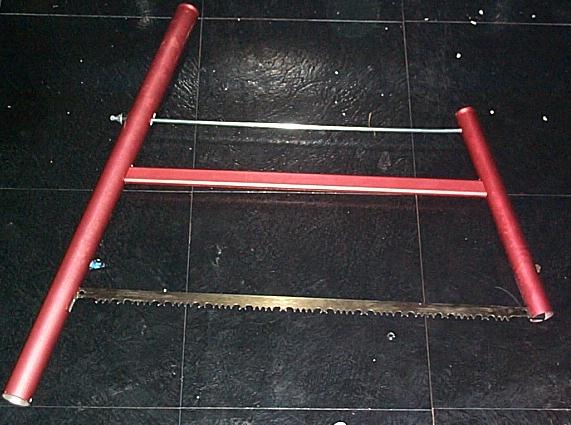
A shot of the Trailblazer :

The saw packs up into a compact 1-3/8" dia. by 25" tube. The open A-frame has 6-1/4" throats and are made of lightweight anodized aluminum. It comes standard with a Swede saw blade for agressive wood cutting action with options for bone and meat saw blades.
The Trailblazer has a very large advantage over most small folding saws like the Felco in cutting small woods (two - four inches). Even when bucking such wood and maximal force can't be applied as the off hand has to be used to hold the wood in place, the Trailblazer still outcuts such quality folding saws by about two to one in regards to time.
As the wood get larger the difference grows, as does the performance more to favor the Trailblazer more when the wood is rigid (as in felling) and doesn't need to be stabilized by the sawer ( ref) . Of course folding saws like the Felco are lighter in weight and more packable, they can readily fit into the glove compartment of a car for example.
Comparing the Trailblazer to other Japanese saws, the Trailblazer still has the advantage but not as much. Moving on to larger woods, cutting up four to six inch pine and fir alongside the Timber Saw from Tashio Hardware averaged the following performance through thiry six cuts of the wood each :
| Model | tpi | blade length | strokes | length of edge | time |
|---|---|---|---|---|---|
| cm | m | seconds | |||
| Trailblazer | 3.5 | 51 | 35 (1) | 17.8 ( 5) | 15.4 (5) |
| Timber Saw | 9 | 31.5 | 62 (3) | 19.4 (10) | 20.3 (8) |
The above numbers don't tell the whole story. When the Timber saw is run really heavy, with a lot of downwards force, the number of strokes required can drop to around 40, however the time suffers then and creeps up to the mid twenties, and the fatigue goes way up. As well, it can be ran really fast, with light pressure, which gains more time, a few seconds, but the stroke count goes way up to around 80 and again fatigue increases.
The Trailblazer is more consistent, it gains little from trying more force down on the blade as the wood could not be held in place with the off hand. It is also much larger and more awkward than the Timber saw and thus not as easy to run really fast. These bow or swede saws are generally made to be used two handed, though really small versions exist. Thus the performance of this saw was not as varied as the Timber saw in regards to force and speed effects.
Overall, at first inspection it would be expected that the Trailblazer should be further ahead. While after just a few cuts it is readily obvious that the Trailblazer has a slight advantage, the main reason why it doesn't pull further ahead is that the wood is too small and has to be held in place with the off hand thus permitting maximal force to be applied to the Trailblazer to allow the heavy teeth to cut to full capacity.
The saw was used for an extended period of time to gauge its overall functionality and versatility.
As it "folds", this saw is much more packable than traditional bow saws, but it still much larger and heavier than a quality pruning saw. While the Trailblazer does have a lot more sawing ability as show in the above, it takes large pieces of wood for the pruning saws to stop being efficient. The Trailblazer can thus be worth the extra weight and somewhat cumbersome package, but it requires wood of decent size.
There is a bone saw blade as an option, but in general the tooth patth is much more restrictive than on even the more coarse pruning blades with the Japanese tooth patterns. The pruning saws can readily cut ropes, and handle very small diameter hardwoods which are very problematic with the Trailblazer which is highly optomized to clear soft woods readily.
This is one area where the Trailblazer has a large advantage over the pruning saws, the teeth are readily filed. Of course the trade off here is that the Japanse teeth are impulse hardened and thus last an extreme length of time on woods, years of heavy sawing.
A more secure grip would be an advantage, this one gets slippery when wet, some grip tape of course can fix this problem. It would also be nice to have a more durable locking pin as the plastic one smears out with repeated use. A blade guard would prevent the tips of the saw from getting blunted while rattling around inside the handle and would also muffle sound.
Comments can be emailed using cliffstamp[REMOVE]@cutleryscience.com or by posting in the following thread :
| Last updated : | 04 : 06 : 2005 |
| Originally written: | 04 : 06 : 2005 |